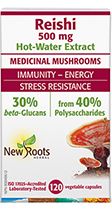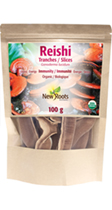Red Reishi: A History of Benefits
Once upon a time, 4,750 years ago, there lived a legendary pioneer of agriculture and herbalogical studies of the Chinese Empire named Shennong. He compiled his knowledge in what is now the most ancient Chinese literary work on plant, animal, and mineral “medicines”: the Shennong Ben Cao Jing. He was renowned for having discovered the healing properties of tea; however for Shennong, the most precious of the natural discoveries was none other than the Lingzhi or red reishi (Ganoderma lucidum).
Ever since, this rare medicinal mushroom has been administered to many emperors—Chinese or not—for its multitude of benefits. Revered in Japan as the “immortal mushroom,” reishi is a symbol of vitality and longevity; a fitting image, as so many scientific studies show its extraordinary capacities to procure real therapeutic benefits.
Today, red reishi is cultivated in ideal conditions, allowing for optimal development of its active ingredients, notably polysaccharides and triterpenes. These can only be extracted from its indigestible chitin shell—which can be irritating and an allergen—using hot water according to the ancestral decoction method.
This fungi panacea is mainly known to:
- Help reduce mental and physical stress symptoms (adaptogen)
- Modulate the immune system
- Support cardiovascular health
- Improve prostate health
- Be used alongside cancer treatments
And it can also benefit the following ailments:
- Inflammation
- Pain
- Muscle stiffness
- Viral infections
- Allergies
- Liver weakness
- Cholesterol
- Hypertension
- Diabetes
- Chronic fatigue
Using 2 g per day of red reishi standardized to 40% polysaccharides provides a “medium” therapeutic dose.
For those who love a good herbal tea—and maybe prefer one with added health benefits—you may choose to make an infusion using slices of the reishi’s fruiting body.
Much like lavender or ginseng, red reishi is part of the panacea family: extraordinary natural remedies which you always want to have close at hand.

 Stores
Stores


